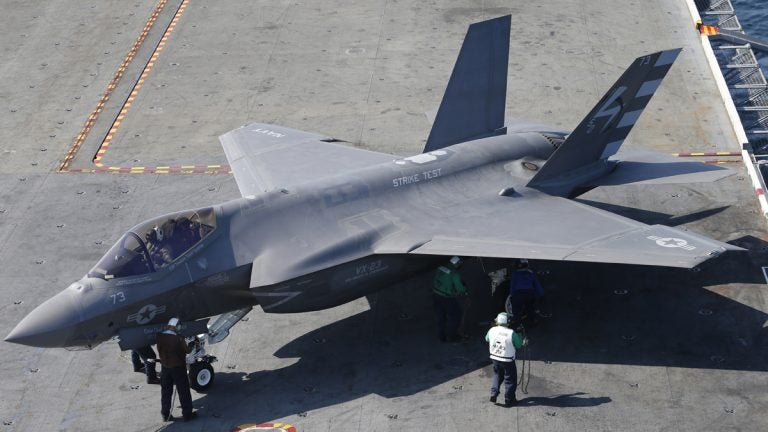Navy jet testing caused today’s sonic booms, military says

An F-35C Lightning II test aircraft taxies on the deck aboard the nuclear powered aircraft carrier USS Dwight D. Eisenhower of the coast of Norfolk, Va., Friday, Oct. 9, 2015. The aircraft is scheduled to be deployed in 2018. (AP Photo/Steve Helber, file)
Naval jet testing is responsible for the multiple sonic booms felt this afternoon at the Jersey Shore and beyond, officials say.
According to a statement from Lt. Col. Tom Crosson, USAF Defense Press Officer, routine aircraft testing in the Atlantic Test Ranges resulted in some maneuvers that could generate sonic booms.
“Today, an F-35C from Naval Air Station Patuxent River, MD was conducting supersonic testing in a cleared military flight area off the East Coast around 1:30 and 2:30 p.m,” the statement said.
It continues:
As with all flight operations, the Navy takes precautions to lessen the impact of testing and training activities on the community. Military aircraft routinely conduct supersonic flights offshore in an area called the Test Track, which parallels the entire coast of the Delmarva Peninsula. Test aircraft from the naval air station execute supersonic flights almost daily in the test track, and most of these sonic booms are never felt on land. However, under certain atmospheric conditions there is an increased potential to hear the sound.
A sonic boom is “the sound associated with the shock waves created by an object traveling through the air faster than the speed of sound. Sonic booms generate enormous amounts of sound energy, sounding much like an explosion,” according to wikipedia.org.
The U.S. Geological Survey reported multiple sonic booms.
From the report: “At least 9 sonic booms were recorded in the following hour and a half. Reported from southern New Jersey along the Eastern Seaboard to Long Island, New York.”
“Felt the earth move under my feet in Toms River,” reported Taneil Sharkey at 1:38 p.m. today on JSHN.
In Mystic Island, Roman Isaryk says the shaking “lasted about 10 seconds,” adding that there are reports from around the area.
(Click to see thousands of reports on JSHN.)
Shaking reports have recently become a yearly event, with some commenting that the ubiquity of social media raises awareness.
In October 2012, a sonic boom was deemed the culprit of ground shaking felt at the Jersey Shore. In February 2014, another sonic boom rattled the same area.
In the hours after the 2014 incident, John Bellini, a geophysicist with the USGS, told NewsWorks that seismometers only detect vibrations within the ground.
“Air blasts and super sonic booms don’t get recorded,” he said. “So if it’s a sonic boom, thunder, or a transformer exploding, there’s no chance of recording it unless it occurs right near the seismometer.”
The last earthquake felt at the Jersey Shore was in August 2011.
WHYY is your source for fact-based, in-depth journalism and information. As a nonprofit organization, we rely on financial support from readers like you. Please give today.

